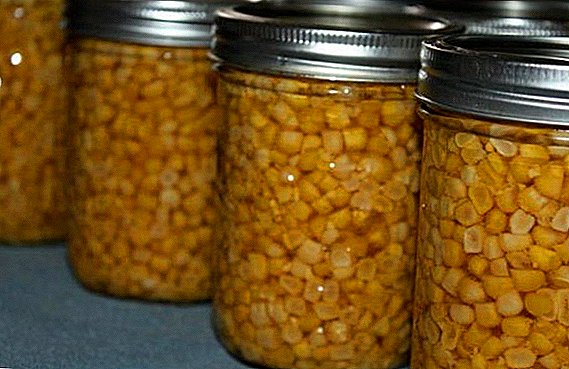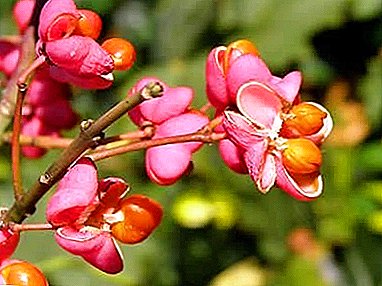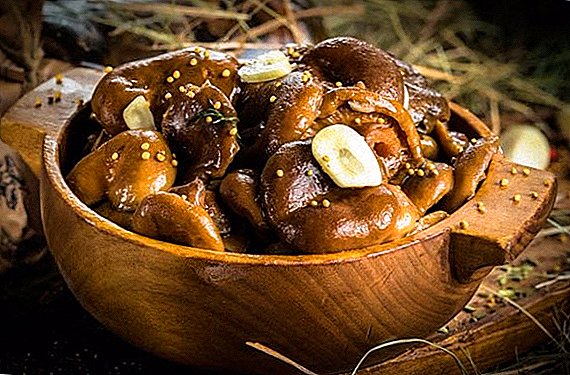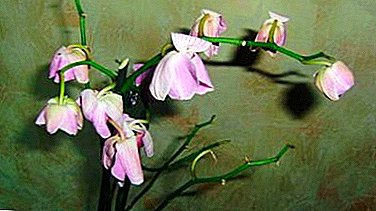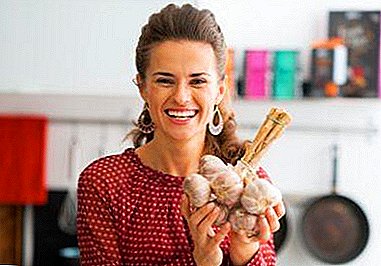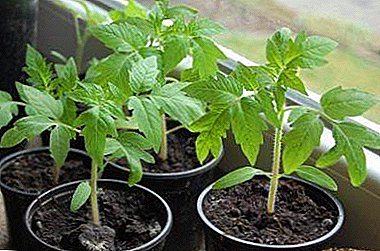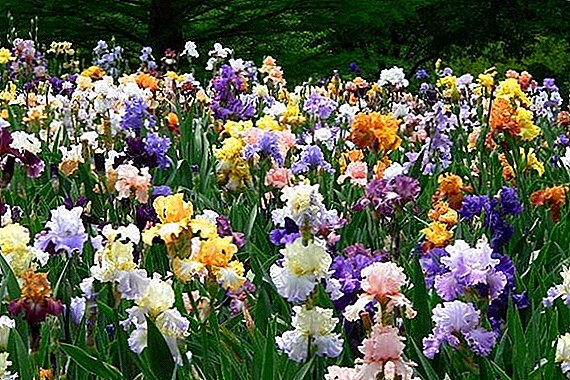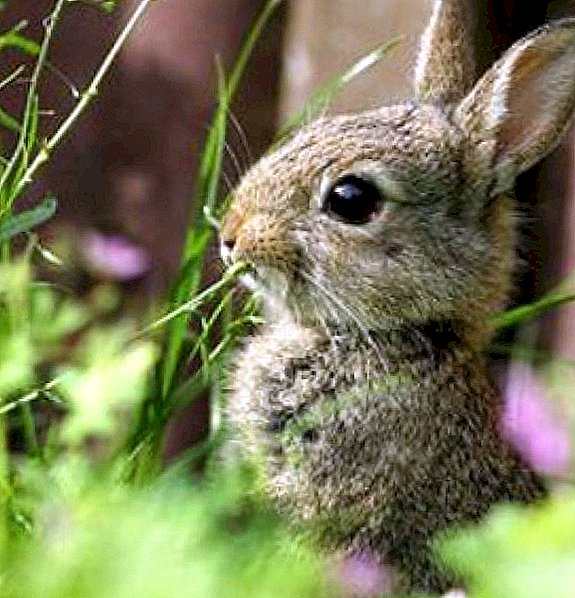 Rabbits, like all rodents, are herbivorous, but this does not mean that they can use any grass.
Rabbits, like all rodents, are herbivorous, but this does not mean that they can use any grass.
It is very important not to make a mistake in selecting useful herbs for your pet, and for beginner breeders it will be useful to know which plants are deadly for these animals.
Is all grass useful?
Most of the nutritious rabbit diet is food of plant origin. From the beginning of early spring to the first frost, rabbits are fed with various herbs, strengthening and nourishing immunity with vitamins, proteins and minerals, as well as enhancing the growth of young individuals. However, it is worth remembering that not all vegetable food is equally useful for these animals, and some - even poisonous.
First we will talk about the herbs necessary for the animal ration, and later we will discuss the name and description of those plants from which the rabbits need to stay away.  Good effect on the growth of pets plant protein, which is contained in seeded green herbs in a young form. Alfalfa, lupine, young oats, winter rye, sulphium, rhubarb and parsnip are excellent components of rabbit nutrition. If plants are harvested "for later", their composition increases the level of fiber, which is poorly digested by the gastrointestinal system of rabbits.
Good effect on the growth of pets plant protein, which is contained in seeded green herbs in a young form. Alfalfa, lupine, young oats, winter rye, sulphium, rhubarb and parsnip are excellent components of rabbit nutrition. If plants are harvested "for later", their composition increases the level of fiber, which is poorly digested by the gastrointestinal system of rabbits.
Also, rabbits prefer: mint, nettle, burdock, wheat grass, sage, parsley, quinoa, sow thistle, lemon balm and cumin.Of course, from some part of the whole grass volume it is just necessary to make preparations for the winter from leaves, flowers and roots, but while it is possible to enrich the diet with vegetable feed in the form of freshly cut grass, you should try not to lose it. In combination with other representatives of the flora, the medicinal dandelion will increase appetite, saturate the body of rabbits with protein, and nettle in combination with dry food will replenish the supply of missing vitamins. The green mass of coltsfoot will improve the digestive process, and wormwood in moderate amounts will cleanse the body of animals from worms.

Important! A great role in the diet will play a variety of herbal species of food. It is necessary to serve grass as a bit of dried fruit as food: in this form it is easier for the animal to digest.
Poisonous plants
The use of certain herbs can be unfavorable or even fatal for domestic rodents. Here is a list of what not to feed rabbits:
- buttercup (lat. ranunculus); other names: Adonis, fierce color, night blindness;
- lumbago (lat. pulsatilla); other names: anemone open, sleep-grass, snowdrops;
- fighter, or aconite (lat. aconitum);
- hellebore (lat. veratrum); other names: puppeteer, chemer, top, cemicary root;
- autumn crocus, or Kolhikum (lat. solchicum); other names: timeless color, sea saffron, autumn color, autumn tree;
- digitalis, or digitalis (lat. digitalis); other names: winegrower, wood bells, wolf foxglove;
- celandine (lat. with helidonium); other names: warthog, chischuha, gladirovnik, swallow grass, chistoplot;
- cicuta, or poisonous (lat. сicuta virоsa); other names: water rabbit, cat parsley, mutnik, gorigolova, pig louse;
- hemlock (lat. sonium); other names: mace, puzzle, tar, poisonous umbrella;
- wild mustard (lat. sinapis arvensis L).
Important! If possible, it will be very useful to grow your own grass for feeding. Such plants as vetch, red clover, sainfoin, Sudanese grass, alfalfa, and ryegrass are of great nutritional value.
Buttercup
Annual and perennial buttercups (herbaceous plants with small yellow flowers) can be seen everywhere: starting from meadow glades and ending with pastures. Their flowering falls on the period from the beginning of spring until the end of late autumn. The danger of this herb for rabbits, as well as other vegetarian animals, is that in its fresh form it contains a poisonous element with an unpleasant smell and a burning taste - protoanemonin. Rabbits do not die from this plant, but apart from losing weight due to acute poisoning and diarrhea, their well-being deteriorates dramatically.  When the mown hay is slightly dried, the level of toxic substance falls, but it is better not to feed them rabbits, especially small ones. The most common types of grass, which should not be given to rabbits: buttercup caustic and poisonous buttercup. From the photo you can see that we all know what this famous, but insidious plant looks like.
When the mown hay is slightly dried, the level of toxic substance falls, but it is better not to feed them rabbits, especially small ones. The most common types of grass, which should not be given to rabbits: buttercup caustic and poisonous buttercup. From the photo you can see that we all know what this famous, but insidious plant looks like.
Did you know? In the work of Shakespeare's "Romeo and Juliet," the apothecary gave the main character a means for immersion in a deadly sleep, which was made from buttercup.
Lumbago
A perennial cross-flowering bloom in the spring (representative of the Buttercup family) is more dangerous to the health of your pets than buttercups. It can be found in open-type forest glades, on sandy soil, as well as dry hills.  Eating fresh grass in the grass can cause digestive system disorders in rabbits, malfunctioning of the respiratory system (shortness of breath) and the heart, as well as convulsions and paralysis. Types of lumbago containing poison: sleep-grass, yellow-lumbago and yellow meadow.
Eating fresh grass in the grass can cause digestive system disorders in rabbits, malfunctioning of the respiratory system (shortness of breath) and the heart, as well as convulsions and paralysis. Types of lumbago containing poison: sleep-grass, yellow-lumbago and yellow meadow.
Fighter
A wrestler, or aconite, as well as two previous species, is from the family of buttercups. It can be found anywhere, because the requirements for the conditions of the plant unpretentious (any terrain, both with dry and wet soil). The most common poisonous types of fighter: normal, tall, large and wolf.  The greatest concentration of poison is in the roots of the plant, and its chemical name - aconitin - is reflected in the name. During flowering, the hazardous substance also spreads on flowers and leaves; when dried, its concentration does not decrease, so it is extremely dangerous to give this grass to your pet in both fresh and dried form. After the use of this type of plant in animals, there is a restless behavior, a tendency to aggression, drooling, slowing heart rate. The most terrible outcome of the use of perennial may be the death of a rabbit from respiratory paralysis.
The greatest concentration of poison is in the roots of the plant, and its chemical name - aconitin - is reflected in the name. During flowering, the hazardous substance also spreads on flowers and leaves; when dried, its concentration does not decrease, so it is extremely dangerous to give this grass to your pet in both fresh and dried form. After the use of this type of plant in animals, there is a restless behavior, a tendency to aggression, drooling, slowing heart rate. The most terrible outcome of the use of perennial may be the death of a rabbit from respiratory paralysis.
Hellebore
A perennial herb from the Melanthian family - hellebore - has two poisonous species: white and lobert. You can recognize them by flowering in the summer on the stems up to a meter white and lemon-green flowers.  Any parts of the plant (both grass and rhizomes) are dangerous for rabbits in any kind: poisoning is accompanied by bowel disorders, unintentional leakage of saliva, tremors, convulsions, and disturbed respiratory processes. In most cases, the animals die.
Any parts of the plant (both grass and rhizomes) are dangerous for rabbits in any kind: poisoning is accompanied by bowel disorders, unintentional leakage of saliva, tremors, convulsions, and disturbed respiratory processes. In most cases, the animals die.
Did you know? Feeding rabbits with hay not only plays a positive role in building a rational and balanced diet, but also helps the animal to grind down its teeth. The abrasive substances contained in dried grass are similar in physical properties to a grinding stone.
Colchicum
The perennial representative of the genus Lileinaceae with large pink or purple flowers - colchicum - is characterized by its damaging effect on the cardiovascular system of herbivores due to the high content of colchicine.  If the plant enters the diet of rabbits, the following symptoms of poisoning may be observed: bowel disorders with blood impurities, increased saliva production and death in 24-48 hours.
If the plant enters the diet of rabbits, the following symptoms of poisoning may be observed: bowel disorders with blood impurities, increased saliva production and death in 24-48 hours.
Digitalis
The perennial foxglove belonging to the family of the Podorozhnikovs (formerly considered to be the representative of the Noricnikovs) has large yellow or red flowers with a purple thimble in the shape of a thimble.
It occurs both on the edges of the forest, and in gardens or cottages. Since this plant is used for medicinal purposes, many are interested in whether it can be given to rabbits. The answer is unequivocal: no, for perennials in any form, this perennial is dangerous.  The effect of poison may not be noticeable at all, but the use of this type of plant ends with the death of rabbits, accompanied by severe convulsions.
The effect of poison may not be noticeable at all, but the use of this type of plant ends with the death of rabbits, accompanied by severe convulsions.
Did you know? The uniqueness of the field of view of rabbits is that they even see what is happening behind their backs: the angle of their view is rotated 360 degrees. Despite this, there are two blind spots: just before the nose and right behind the nape of the animal.
Celandine
The perennial representative of the Poppy family flora with flowers of golden yellow color - celandine - is characterized by an unpleasant repulsive odor.  Cramps, disorders of the digestive system (diarrhea), general fatigue, weakness and lethargy are the main signs of the use of celandine in rabbits.
Cramps, disorders of the digestive system (diarrhea), general fatigue, weakness and lethargy are the main signs of the use of celandine in rabbits.
Cicuta
The plant of the hemlock, which also bears another name — the poisonous one — is no less dangerous for rabbits. A perennial member of the Umbrella family can be recognized for small white flowers, as well as a pervasive smell resembling celery. Distributed on the banks of reservoirs, as well as in some parts of the marshland.  The poison contained in the plant - cycutotoxin - is famous for its strong damaging effect on the work of the respiratory organs, resulting in paralysis and death for the animal.
The poison contained in the plant - cycutotoxin - is famous for its strong damaging effect on the work of the respiratory organs, resulting in paralysis and death for the animal.
Hemlock
Another representative of the umbrella family - hemlock, or spotted omeg - can be recognized by the hemlock-like flowers gathered in umbrellas, as well as the not very pleasant smell coming from the plant. It grows mainly in the gardens, as well as abandoned wastelands.  The usual signs of poisoning by a plant (disorders of the digestive system, salivation) are complemented by paralysis of the hind legs, and later - death.
The usual signs of poisoning by a plant (disorders of the digestive system, salivation) are complemented by paralysis of the hind legs, and later - death.
Wild mustard
Wild or field mustard is a representative of the Cruciferous family, distinguished by its yellow flowers, and also by pod-like fruits. At a young age, the plant is not dangerous, but when seeds appear, mustard oil begins to be produced in it.  When poisoning in rabbits, there is flatulence, impaired defecation (diarrhea), often with blood discharge.
When poisoning in rabbits, there is flatulence, impaired defecation (diarrhea), often with blood discharge.
Important! In addition to the TOP-10 of the most common poisonous plants for herbivores, rabbits can also be harmed by the following plants: marsh marigold (perennial with bright golden-yellow flowers); cornflowers horned (plant with purple or bluish flowers); Datura ordinary (has white flowers of large size); wild radish; Avran officinalis (perennial with yellowish white flowers); the marsh calla (has cob-shaped small flowers and bright red berries); sowing cockle (possesses large flowers of bright red or crimson color); horse dill.
Grass requirements
For proper and efficient rabbit breeding, an important aspect is not only knowing which plants can or should not be given to these pets, but also how, in what quantity and at what time they should be fed in order to avoid problems with feed digestion. 
Learn more about rabbits such as: Californian, Gray Giant, White Giant, Rex, Butterfly, Baran, Risen and Black Brown.
Compliance with the following simple rules for feeding pets will affect the quality and calorie content of meat, as well as the effectiveness of rabbit skin:
- Feed the rabbits at the same time.
- The basis of all feed is grass (in the winter season - hay). Rotted or moldy grass is thrown away. The diet should be freshly mown, but slightly dried; or dry, but with green.
- Adults require a dosage of no more than 1 kg of grass per day, young animals from 100 to 400 g (norms of hay are reduced approximately 4 times in winter).
- It is necessary to lay the grass in the feeders some time after mowing, and after a longer time, if the herbaceous plants were mown in early dew or after rain. Due to the fact that the gastrointestinal tract of rabbits is very sensitive to raw vegetable food, slightly dried grass is the very thing for enriching the body of the animal with nutrients and vitamins.
- New grass for feeding should be introduced into the diet gradually (throughout the week), and the drinking bowl should always be filled with clean water.
Important! Legumes containing protein and amino acids have a good effect on growth and weight gain in rabbits.
 An indisputable fact is that a properly organized diet of our pets is one of the main elements of their healthy development.
An indisputable fact is that a properly organized diet of our pets is one of the main elements of their healthy development.
So, we understand the list of plants that positively affect the growth of rabbits, the basic rules for feeding animals, and also considered the types of poisonous grass that threatens rabbits with diseases, and even death.
We advise you to get acquainted with such diseases of rabbits and the methods of their treatment: coccidiosis, pasteurellosis and myxomatosis.
On this basis, when preparing food, it is necessary not only to saturate it with basic nutrients and elements, but also to be extremely careful, ensuring that even small particles of the above-mentioned toxic flora do not get into it. 


